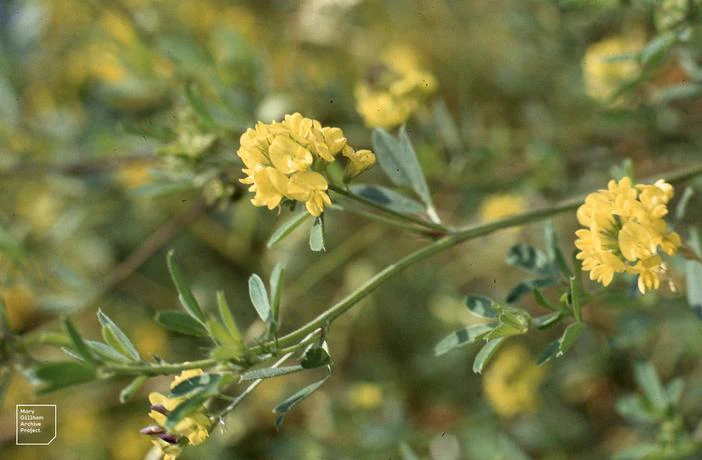Alfalfa
(Medicago sativa subsp. x)
Alfalfa (Medicago sativa subsp. x)
/
/

Dr Mary Gillham Archive Project
CC BY 2.0
Image By:
Dr Mary Gillham Archive Project
Recorded By:
Copyright:
CC BY 2.0
Copyright Notice:
Photo by: Dr Mary Gillham Archive Project | License Type: CC BY 2.0 | License URL: https://creativecommons.org/licenses/by/2.0/ | Uploader: Mary Gillham Archive Project | Publisher: Flickr





Estimated Native Range
Climate Requirements
| • Precipitation | 29" - 40" |
| • High Temp. | 69°F - 74°F |
| • Low Temp. | 23°F - 28°F |
Summary
Medicago sativa subsp. x, commonly known as Alfalfa, Purple Medic, or Lucerne, is a perennial herb native Europe and the Near East. It typically grows to a height of 1-3 feet (0.3-0.9 meters) and a width of 1-2 feet (0.3-0.6 meters). Alfalfa is characterized by its trifoliate leaves and erect flowering stems, with purple flowers that are quite showy and bloom in the summer. The plant is also known for its deep taproot system, which allows it to access nutrients and water from deeper soil layers.
Alfalfa is highly valued in cultivation for its nitrogen-fixing abilities, which enrich the soil, and for its use as high-quality forage for livestock. It is also grown as a cover crop to improve soil structure and as a green manure. In gardens, it can be used as an ornamental plant for its attractive flowers. Alfalfa requires full sun and does well in a range of soil types, including clay, loam, or sandy soils, provided they have medium to fast drainage. It is drought-tolerant once established but benefits from medium amounts of water during dry periods. While generally easy to maintain, alfalfa can be susceptible to fungal diseases and pests such as aphids and weevils. It is also important to note that alfalfa can become invasive if not managed properly, spreading through its prolific seed production.CC BY-SA 4.0
Alfalfa is highly valued in cultivation for its nitrogen-fixing abilities, which enrich the soil, and for its use as high-quality forage for livestock. It is also grown as a cover crop to improve soil structure and as a green manure. In gardens, it can be used as an ornamental plant for its attractive flowers. Alfalfa requires full sun and does well in a range of soil types, including clay, loam, or sandy soils, provided they have medium to fast drainage. It is drought-tolerant once established but benefits from medium amounts of water during dry periods. While generally easy to maintain, alfalfa can be susceptible to fungal diseases and pests such as aphids and weevils. It is also important to note that alfalfa can become invasive if not managed properly, spreading through its prolific seed production.CC BY-SA 4.0
Plant Description
- Plant Type:
- Height: 1-3 feet
- Width: 1-2 feet
- Growth Rate: Rapid
- Flower Color: Purple
- Flowering Season: Summer
- Leaf Retention: Deciduous
Growth Requirements
- Sun: Full Sun
- Water: Medium
- Drainage: Fast, Medium
Common Uses
Bee Garden, Edible*Disclaimer: Easyscape's listed plant edibility is for informational use. Always verify the safety and proper identification of any plant before consumption., Erosion Control, Low Maintenance
Natural Habitat
Native to warmer temperate climates, including the Near East and Mediterranean regions, typically found in well-drained, fertile fields and meadows
Other Names
Common Names: Purple Medic , Lucerne
Scientific Names: Medicago sativa subsp. x varia , Medicago falcata x sativa , Medicago falcata × sativa , Medicago sativa ssp. x varia , Medicago sativa ssp. × varia , Medicago sativa subsp. × varia
GBIF Accepted Name: Medicago sativa subsp. x